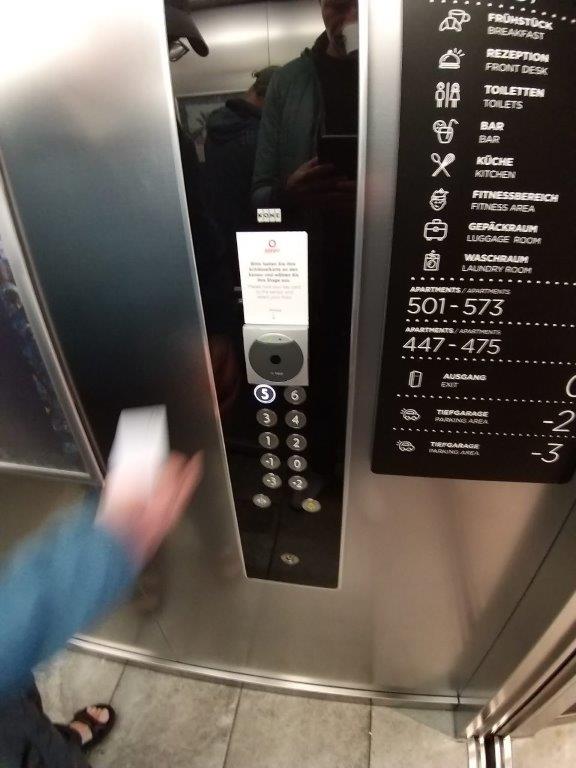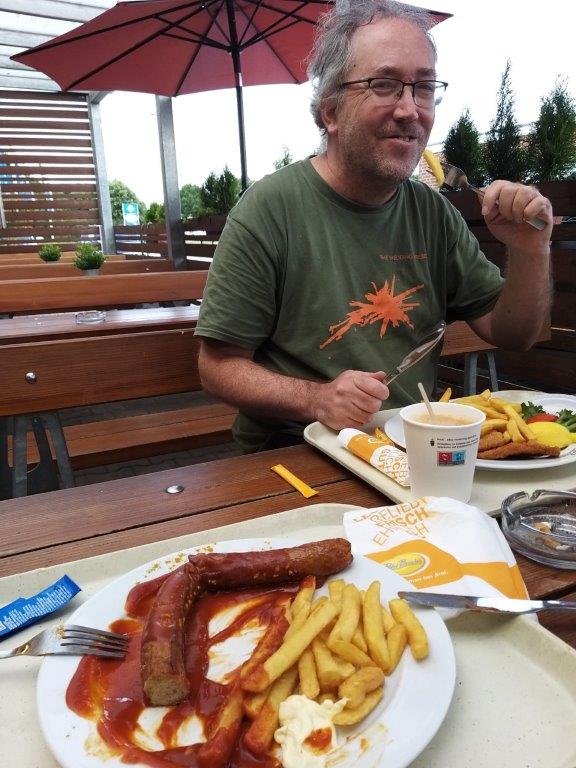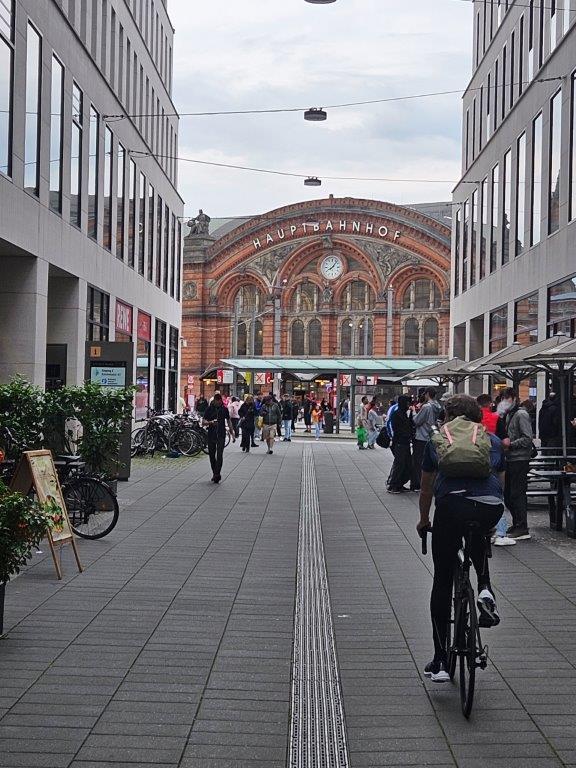1. Citytrip to Hanseatic Bremen – Journey and arrival
2023 was a year in which The Wandelgek travelled more in the vicinity of The Netherlands. He started travelling in Spring and visited Brussels for a couple of days. In early Summer he decided to go on another citytrip, this time to sister Hanseatic Town of Bremen in northern Germany. This was a very first visit indeed and he didn’t quite know what to expect.
On the German Autobahn he found a small restaurant at a gasoline station where he had diner: Currywurst with fries and Schnitzel 😋.
After arrival in Bremen it was quickly checking in and putting the luggage in the hotelroom.
In the hotel lobby there was a nice teevee screen which showed lots of what The Wandelgek wanted to visit in this for him new town:
For most of its 1,200 year history, Bremen was an independent city within the confederal jurisdiction of the Holy Roman Empire. Its governing merchants and guilds were at the centre of the Hanseatic League that sought to monopolise the North Sea and Baltic Sea trade. To enlarge and confirm its independence, the city had, until the Reformation, to contend with the temporal power of the Church, and after the Thirty Years’ War with Sweden, the masters of the surrounding Duchy of Bremen-Verden. George 1 Louis, the Elector of Hannover (and from 1714, King of Great Britain and Ireland) who in 1715 acquired Bremen-Verden, recognized Bremen as a free city in 1720. The city was captured in 1806 and then annexed by France in 1810, before it regained independence in 1815.
In 1871, Bremen was drawn by Prussia into the German Empire. With its new sea anchorage and wharves at Bremerhaven, it was the principal port of embarkation for German and central European emigrants to the Americas, and an entrepôt for Germany’s late developing colonial trade. The Norddeutscher Lloyd (NDL), founded in Bremen in 1857, became one of the world’s leading shipping companies.
After the First World War, Bremen, a broadly liberal and social-democratic city, and briefly a Council or Soviet republic, lost its autonomy under the Hitler regime. During World War II, it was the location of nine subcamps of the Neuengamme concentration camp, mostly for French, Polish, Soviet and Jewish men and Jewish women. After the war, in which almost two thirds of the city’s fabric was destroyed, the autonomy was restored. Bremen became one of the founding Bundesländer (or states) of the Federal Republic (West Germany).
Geography
Bremen lies on both sides of the River Weser, about 60 kilometres (37 miles) upstream of its estuary on the North Sea and its transition to the Outer Weser by Bremerhaven. Opposite Bremen’s Altstadt is the point where the “Middle Weser” becomes the “Lower Weser” and, from the area of Bremen’s port, the river has been made navigable to ocean-going vessels. The region on the left bank of the Lower Weser, through which the Ochtum flows, is the Weser Marshes, the landscape on its right bank is part of the Elbe-Weser Triangle. The Lesum, and its tributaries, the Wümme and Hamme, the Schönebecker Aue and Blumenthaler Aue, are the downstream tributaries of the Weser.
The city’s municipal area is about 38 kilometres (24 miles) long and 16 kilometres (10 miles) wide. In terms of area, Bremen is the eleventh largest city in Germany; and in terms of population the second largest city in northwest Germany after Hamburg and the eleventh largest in the whole of Germany.
Bremen lies about 50 kilometres (31 miles) east of the city of Oldenburg, 110 kilometres (68 miles) southwest of Hamburg, 120 kilometres (75 miles) northwest of Hanover, 100 kilometres (62 miles) north of Minden and 105 kilometres (65 miles) northeast of Osnabrück. Part of Bremerhaven’s port territory forms an exclave of the City of Bremen.
Hills of Bremen
The inner city lies on a Weser dune, which reaches a natural height of 10.5 metres (34 feet, 6 inches) above sea level at Bremen Cathedral; its highest point, though, is 14.4 metres (47 feet, 3 inches) above sea level and lies to the east at the Polizeihaus, Am Wall 196. The highest natural feature in the city of Bremen is 32.5 metres (107 feet) above sea level and lies in Friedehorst Park in the northwestern borough of Burglesum. As a result, Bremen has the lowest high point of all the German states.
 Then he took the elevator to install himself in his room and have a look around:
Then he took the elevator to install himself in his room and have a look around:
Hotelroom
Bedroom & kitchen
The hotelroom had a television and a small open kitchen.
Window view
The view from the window was over the Bremen HauptBahnhof (Central Station of Bremen) and the great square in front.
The sculptures on the façade, among other railway-related symbolisms, depict the coats of arms of the cities of Bremen and Hamburg, the original destinations of the line.
There is a large mural inside the station’s main hall, dating back to the 1950s and showing scenes from the city port. It went into oblivion when it was drywalled off and station announcement boards were put over it in the 1970s, but has been carefully renovated at the station’s most recent interior overhaul and is now viewable to the public again.
Daylight
Night
Bremen’s first train station was opened in 1847 on the site of today’s station, on the line to Hanover. Later, lines leading to Vegesack (Bremen-Vegesack–Bremen line), Bremerhaven (then Wesermünde, Bremen–Bremerhaven line), Oldenburg and Uelzen (Uelzen–Langwedel railway) were connected to the station. In 1870, the Köln-Mindener Eisenbahn, opening its Wanne-Eickel–Hamburg line (Rollbahn), built another station some hundred metres north of the old station, since the old station could not cope with the additional Rollbahn traffic. Eventually, it was decided that a single station would be better, and so today’s station was built from 1886 to 1891 after plans by Hubert Stier, with sculptures by Diedrich Samuel Kropp and Carl Dopmeyer. In 1907, additional tracks were added. Whilst the station hall has been remodeled several times due to war damage and modernisation, its basic outline still resembles the original 1880s building.
The station hall was thoroughly renovated in the late 1990s and early 2000s, merging the two formerly separated passenger tunnels into a single concourse. Since 1973, it is protected by the monument protection act. The station’s platforms, however, were only partially renovated, but are expected to be refurbished from 2008 on for €12.6 million.
While the station enjoyed a great reputation throughout much of its history, when Consumer Choice Center ranked Europe’s top 50 railway stations in 2022, Bremen Hauptbahnhof ranked last
Bathroom
The bathroom had a shower, a toilet, but no bath …
Then it was time to go and explore the town …
First The Wandelgek walked toward the Marktplatz (Market square) which is the central square of Bremen. To get there he walked from the square where his hotel was and the Central Railway Station, toward the inner city, crossing the ancient city moat, which is like in Deventer the moment when entering the old town.
Deleted:  At the moats embankments there was space for biodiversity …
At the moats embankments there was space for biodiversity …


There was a beautiful Windmill built upon the remnants of the cities city walls…
A total of five windmills from the 17th and 18th centuries have been preserved in Bremen to this day. One of them is the mill in the Wallanlagen, also called “Mühle am wall”, Bremen’s old city fortifications, whose walls were ground down in 1802 and turned into a park.

Although it burnt down completely twice in the 19th century, it was rebuilt again and again.

Flour was ground here until 1947, and today the mill hosts a café.
 It was a bit of a shame though that the mill had been closed, due to it being sold to another company.
It was a bit of a shame though that the mill had been closed, due to it being sold to another company.
 Near the moat was a beautiful statue of the famous 1st mayor Kaisen of Bremen after the 2nd World War, who was an important stimulator of the rebuilding of the heavily bombarded city. The Wandelgek was getting more and more curious and interested in the history and in how this destructed town center had been revamped …
Near the moat was a beautiful statue of the famous 1st mayor Kaisen of Bremen after the 2nd World War, who was an important stimulator of the rebuilding of the heavily bombarded city. The Wandelgek was getting more and more curious and interested in the history and in how this destructed town center had been revamped …

Next the route to the Marktplatz went through some shopping streets, like e.g. the:
Sögestraße
where he saw this statue of a shepard blowing a horn and a bunch of pigs and probably a headless dog accompanying him. First mentioned in documents dating back to 1261, the street was once home to bakers and brewers who used their waste to raise pigs. The Low German word “Söge,” meaning “sow” in High German, gave it its name. The group by sculptor Peter Lehmann was donated by local residents when the area was converted into a pedestrian zone in 1973.
See the next blogpost for my visit to the Bremer Marktplatz.






































































